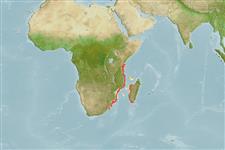Common names from other countries
Environment: milieu / climate zone / depth range / distribution range
Ecologia
; intervalo de profundidade 180 - 750 m (Ref. 106911), usually 400 - 500 m (Ref. 106911). Tropical, preferred 26°C (Ref. 107945); 3°S - 33°S, 31°E - 46°E (Ref. 4)
Southwest Atlantic and Indo-West Pacific: from Kenya to Natal.
Length at first maturity / Tamanho / Peso / Idade
Maturity: Lm 4.9, range 3 - ? cm Max length : 20.5 cm TL macho/indeterminado; (Ref. 122061); 20 cm TL (female)
It has a maximum total length of 20.5 cm (male) and 20 cm (female); and carapace lengths of 4.5 to 8.8 cm (male) and 3.7 to 8.3 (female). Minimum depth range from Ref. 122059. Occurs at depths from 200 to 750 m, but most common between 400 and 500 m (Ref. 4). Occurs along the edge of the continental slope on soft muddy substrata (Ref. 106911).
Life cycle and mating behavior
Maturidade | Reprodução | Desova | Ovos | Fecundidade | Larvas
Ovigerous females between December and June (Ref. 4).
Holthuis, L.B. 1991. (Ref. 4)
Categoria na Lista Vermelha da IUCN (Ref. 130435)
Categoria CITES (Ref. 108899)
Not Evaluated
Not Evaluated
Utilização humana
Pescarias: espécies comerciais
FAO - pescarias: landings | FishSource | Sea Around Us
Ferramentas
Mais informação
Idade/Tamanho
Crescimento
Comprimento-peso
Comprimento-comprimento
Morfologia
Larvas
Abundância
Fontes da internet
Estimates based on models
Preferred temperature
(Ref.
115969): 10 - 12.3, mean 11.4 (based on 9 cells).
Resiliência
Elevada, tempo mínimo de duplicação da população menor que 15 meses (K=0.45-0.48).
Vulnerabilidade
Low vulnerability (11 of 100).
